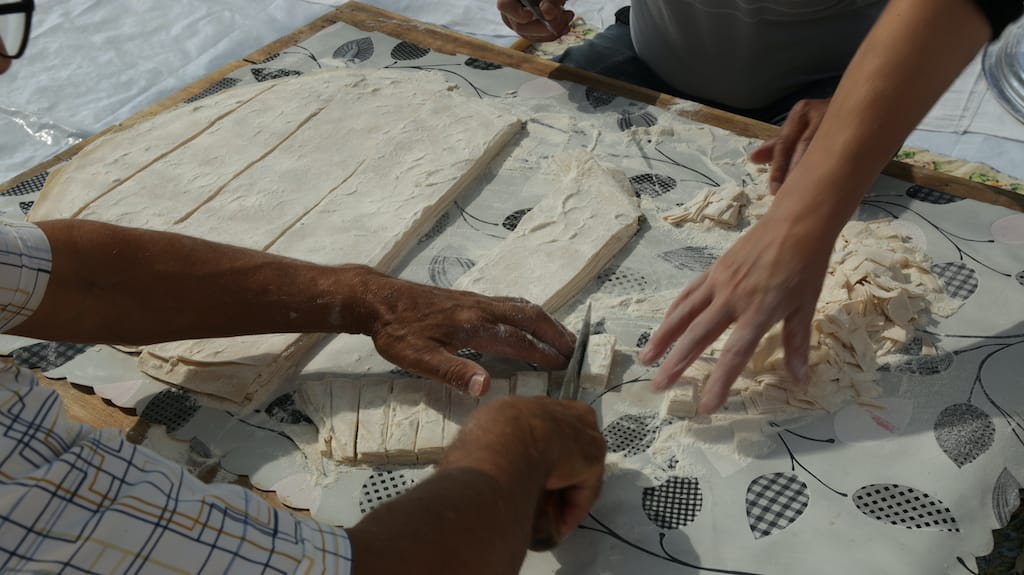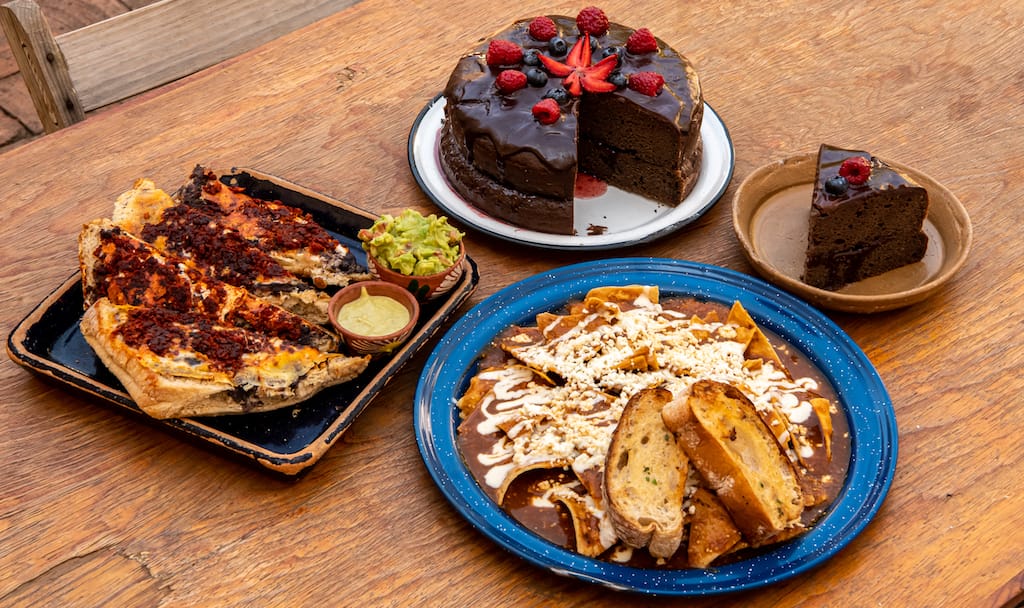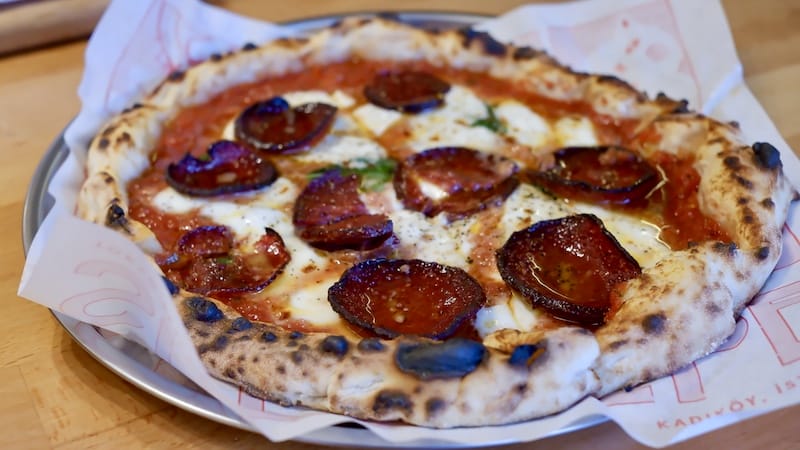In the Yayladere district of Bingöl, one of Turkey’s eastern provinces, nestled in a valley in the foothills of the mountains known by the local Kurdish population as Silbûs û Tarî, lies the village of Conag. Come summer, the women of the village carry out a tradition that has been upheld in the region for some three centuries: rolling out and then drying a type of noodle known as êrişte.
They come together every year in September to roll out the dough made with flour, salt and water, to be sun-dried and finally cut into square-shaped pieces that will be used as the main ingredient of the traditional noodle, yogurt and wild thyme soup gêrmiya êrişte. The softer sunlight at this time of year is perfect for drying êrişte (pronounced eh-rish-te) without it cracking.
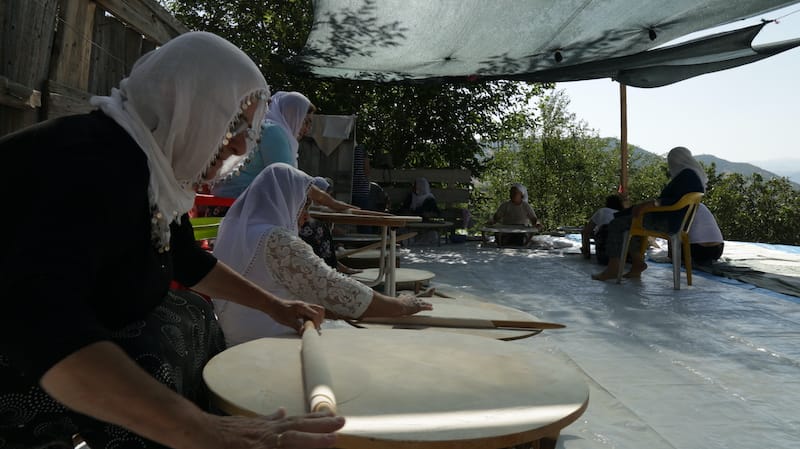
The women of Conag, many of whom are in their sixties and seventies now, mostly live in Istanbul. Yet they spend almost every summer in the village, wanting to stay connected to their hometown as much as they can. The people of Conag, like many others in the Kurdish cities of Turkey, had been forced to leave their homes nearly 40 years ago as a result of the fighting between Turkish forces and guerillas of the Kurdistan Workers’ Party (PKK). But the number of villagers going back to Conag is increasing every year and now it has around 50 people during summer. They spend most of their time caring for gardens and sometimes raising livestock in the village like they used to after years of forced exile.
The women preserve their local culture by singing kilams (Kurdish folk songs) and dancing govend (a traditional Kurdish dance) at picnics whenever they are together. Making êrişte (which in Turkish is spelled erişte and usually refers to a longer and thinner egg noodle) is another one of those efforts, and specifically one of the last few traditions carried out by women ever since the days when wheat was harvested from the fields by oxcart and turned into flour in the mills after months of hard work.
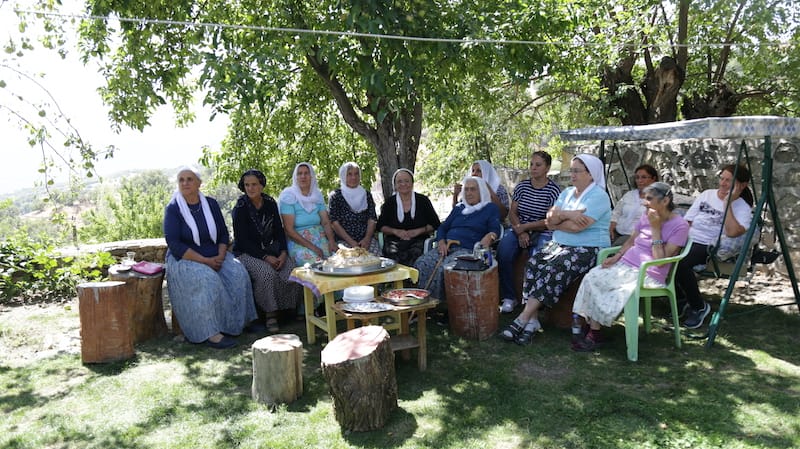
This year, the êrişte season kicked off at Mala Xanê (the house of Xanê – in the local Kurdish culture, every house has a name). To help roll out the êrişte dough, every woman in the village was invited to Mala Xanê with their dough-rolling tools, namely a short-legged round wooden table and a wooden pin.
Considering the amount of dough as well as its density, kneading itself could be the most difficult part of it all. Luckily, one villager, Fatma, who is a distant cousin of the hosts, volunteered to do the kneading.
First thing in the morning, after milking her cows, she came over and truly impressed everyone by making not only the dough for êrişte,which is tiresome on its own, but also the dough for zirvet, a traditional Kurdish pastry specific to the region. The dough for this dish is baked in the oven, then the middle is carved out and cut into small pieces to be put back in, creating a sort of mountainous pie. To add flavor, melted butter and diluted çûrtan (sun-dried hard toraq, a Kurdish cottage cheese) are poured over the mountain. It is served to the erîşte-makers for them to enjoy after a hard day’s work.
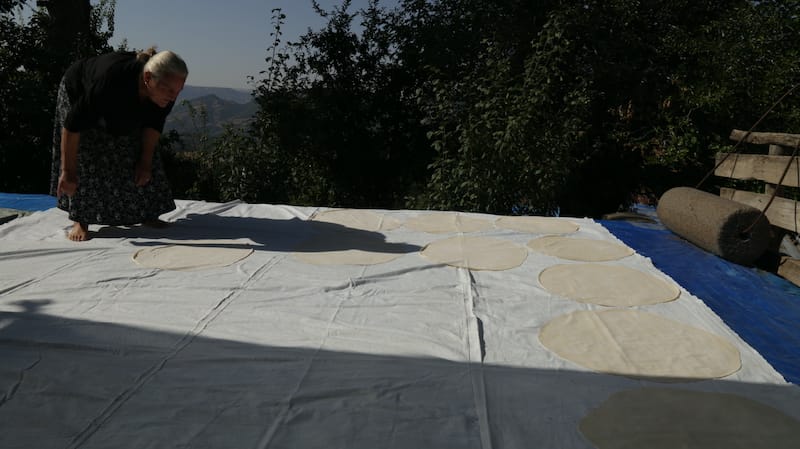
Fatma kneaded the dough while saying prayers in Kurdish, repeating the words “Ya Allah, give health to our young people, keep our old people in good health, don’t give us grief and grant us to eat with health.”
The women gathered outside Mala Xanê under the shade of an overhanging canvas and began to roll out the dough. Two of the women had taken the responsibility of cutting it into orange-sized chunks and distributing them to the rollers at the rolling tables. Each woman rolls out their piece of dough and gradually widens it into a paper-thin sheet almost the same size as the table. The sheet is then gently put on the pin and handed to the person who is responsible for laying it out on a cloth on the floor to dry in the sun.
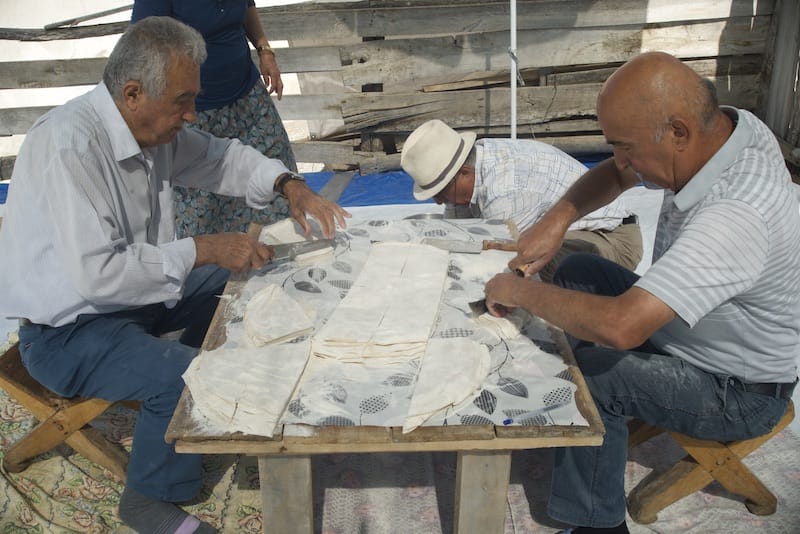
When the edges of the dough start to curl up, signaling that it is dry enough, the sheets are collected one by one and piled up on a flat metal tray with plenty of flour sprinkled between each layer to keep them from sticking. The stack of dough is then taken to the men’s table. Unlike many villages in the neighborhood, men in Conag have been working with women in making êrişte since the beginning of the tradition.
Here, the stacks are first cut into strips and then each strip is cut again into small square pieces. This is the final stage of êrişte making. The êrişte pieces will then be put in boxes or containers for storage, as they are made exclusively to be used as the main ingredient of gêrmiya êrişte, which is predominantly cooked on cold winter days.
The rhythmic snapping as Uncle Husnî cuts the êrişte sounds like the plucking strings of an instrument, and this sound, mixing with the hubbub of the village working together, is the orchestra of êrişte. After going a whole year without hearing it, this music is as nourishing as its taste.
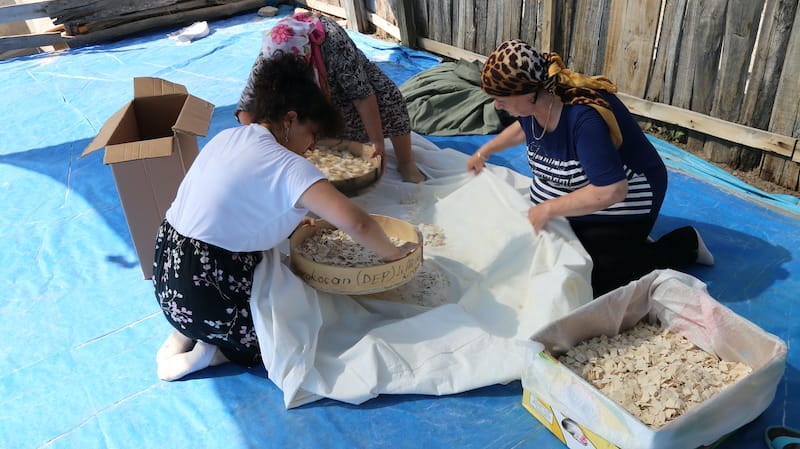
With everyone working in collaboration, the êrişte day finished by noon. Hungry and tired, the women, many who had not even had breakfast, regained their energy by eating zirvet and drinking plenty of tea. During the êrişte–making season, they will continue to help each other out in different houses of the village in the following days.
Until the 1990s, the people of Conag still planted wheat and milled their own flour. And until the 1980s, the villagers would spend summers in the highlands taking their cattle with them, where they would also produce çûrtan, another traditional ingredient that gives gêrmiya êrişte its unique taste. But after the Turkish state banned traveling to the highlands in the Kurdish cities in that decade, the villagers were not able to produce çûrtan anymore. It has since been substituted with buttermilk made from homemade yogurt, which has a similar taste.
Along with êrişte, anix (a wild thyme endemic to the region) is another key ingredient exclusive to gêrmîya êrişte. Pan fried in butter and then added to the soup as a final touch, the scent of the warmed up anix is hard to resist. The herb is collected at the end of July up in the high hills and mountains of the region, then sun-dried and ground. Since acquiring the main ingredients of this traditional dish is not as easy as it once was, the tradition of making authentic gêrmiya êrişte is also endangered. In the name of preserving it, people of the region are settling for substitutes. For example, the original recipe’s spelt flour is these days replaced with whole wheat flour.
Nevertheless, the recipe is kept as traditional as possible by those who prepare it. Gêrmiya êrişte is made by mixing yogurt (originally diluted çûrtan), water, egg yolk, flour and salt in a bowl until they are well combined. In a separate pot, bring water to a boil and add the êrişte, cooking it for about 5 minutes. It’s best to gently pour the whipped yogurt mixture into the boiling water, stirring constantly, and let it boil for another 10 minutes. Optionally, qarme (dry-fried cube-like pieces of beef cured in salt and its own fat), pre-cooked chickpeas or green lentils can be added during the final two minutes of cooking before turning off the heat. In another pan, lightly stir-fry thyme in butter until it turns golden brown. The soup is then served in bowls and drizzled with the fried thyme-butter mix for a delicious finish. (Alternatively, the thyme-butter sauce can be poured directly into the pot.)
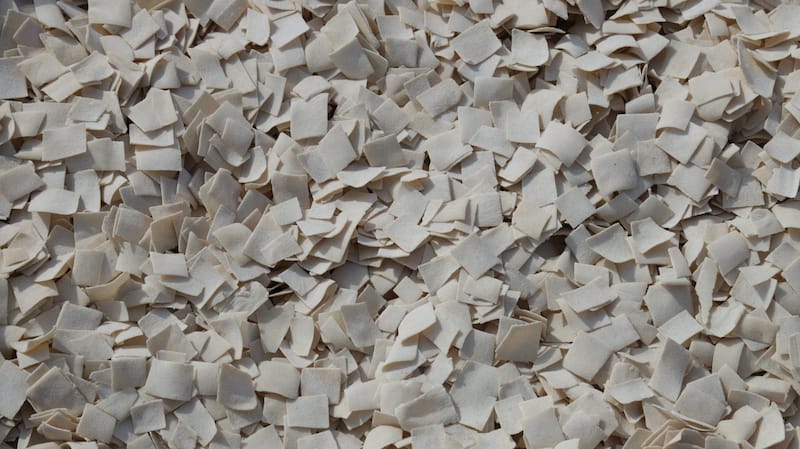
Although this delightful dish continues to grace Kurdish tables, such a cherished tradition may someday disappear. Despite the fact that women – like those of Conag village – continue to resist the erosion of their culture by making êrişte and are determined to keep this tradition alive, it is a sad reality that the youngest still making it are in their fifties and may not be able to carry on this special tradition for too long. Which makes the êrişte-making session held this summer by the women of Conag all the more special.
(Editor’s Note: Even if you don’t plan on cooking the soup, we recommend you watch this recipe video for Gêrmiya Êrişte by Memlî Seven.)
Hilal SevenElif Yiğit
Published on December 04, 2023
Related stories
April 11, 2024
OaxacaAs difficult as the last two years have been for food businesses, it has offered many establishments an opportunity to rethink how they do things and come back with a greater sense of purpose. Take the example of Oaxaca’s Oscuro Brebaje, a café that took a pause, only to emerge stronger and more inviting. Founded…
March 6, 2024
IstanbulThe fourth time was the charm when we finally were able to take a seat at Salepepe, a five-stool pizza bar in the exceedingly hip neighborhood of Yeldeğirmeni, located in Istanbul's Kadıköy district on the Anatolian side of the city. When we first went, the restaurant was closed due to selling out early, while the…
December 6, 2023
IstanbulErgenekon Avenue, the busy, one-way street that separates the Istanbul quarters of Kurtuluş and Pangaltı, is particularly bustling at the Osmanbey metro exit. For years now, the heavy foot traffic has outgrown its narrow sidewalks, peaking into an insurmountable throng at evening rush hour. On one side is an expansive walled Levantine Catholic cemetery, while…







































